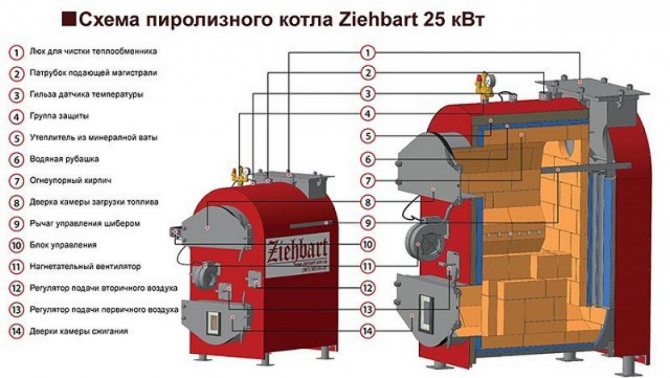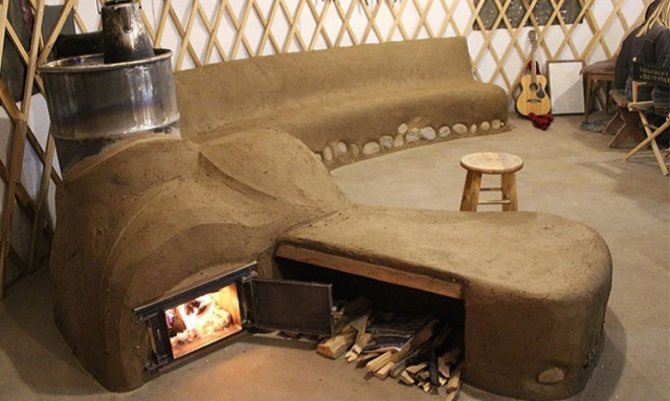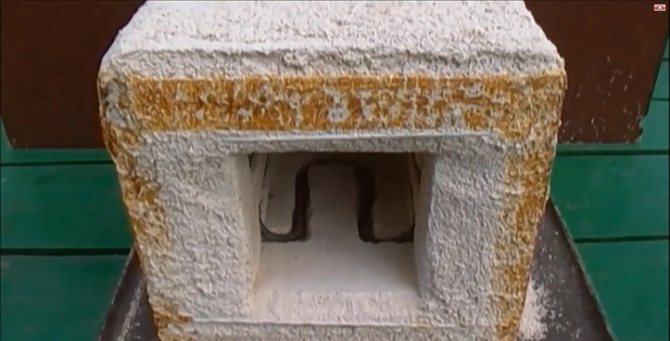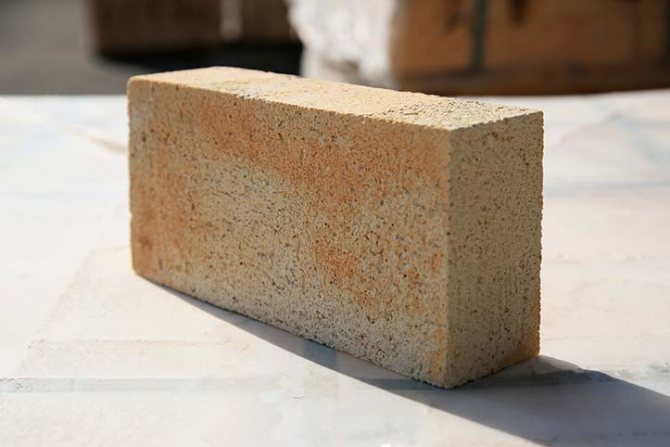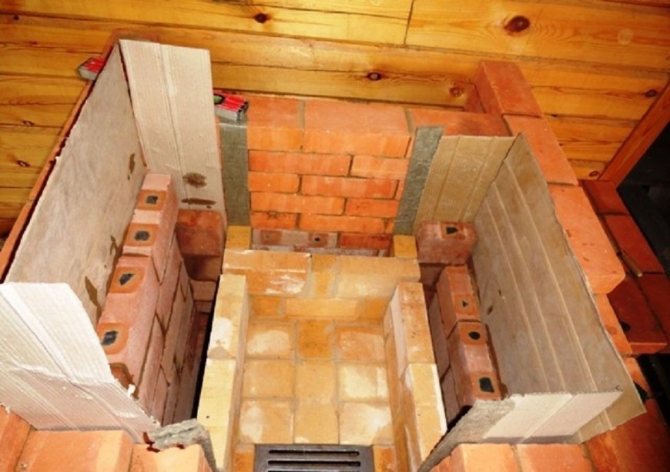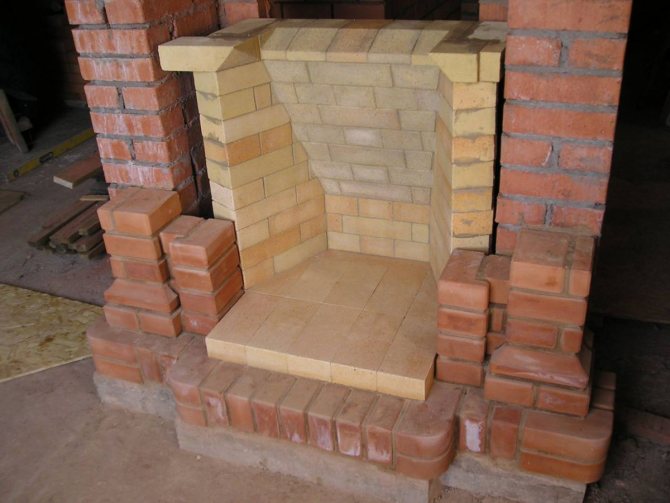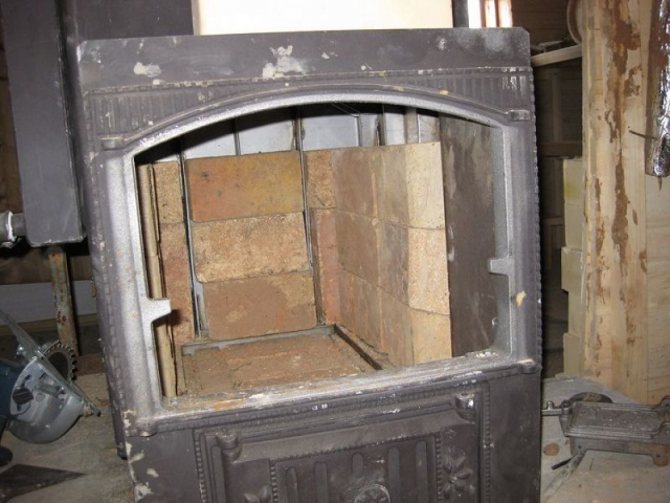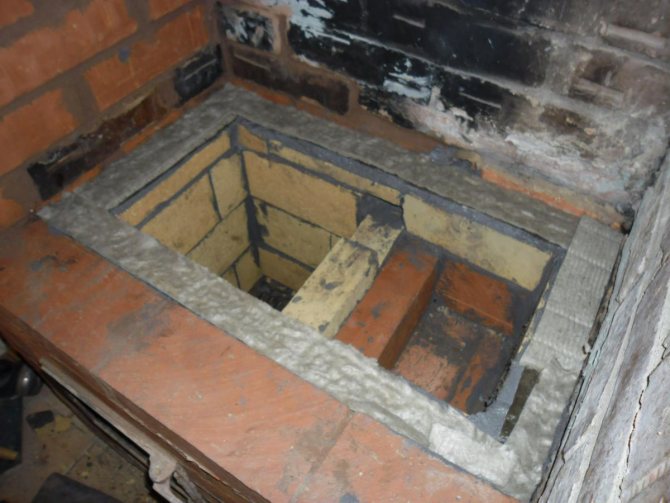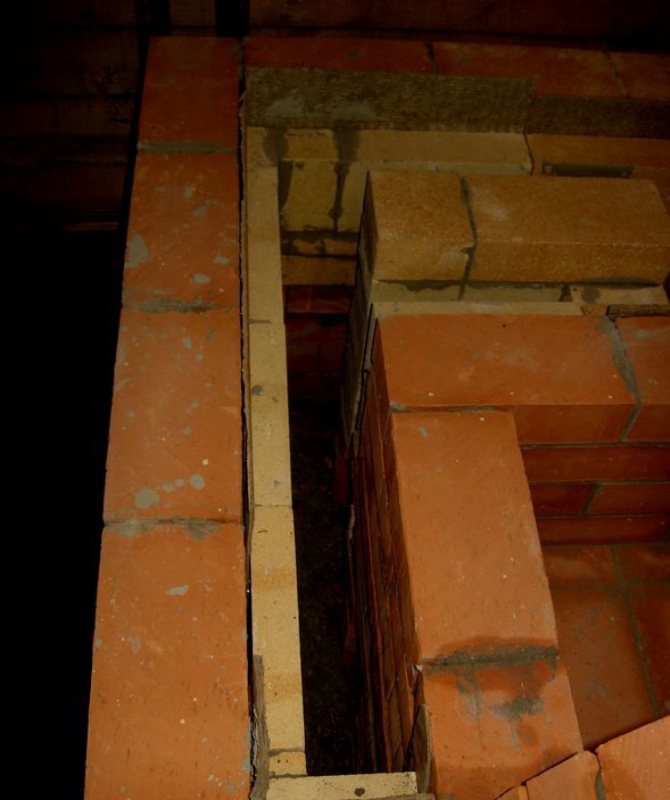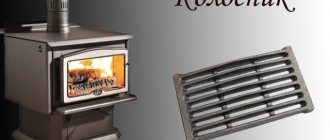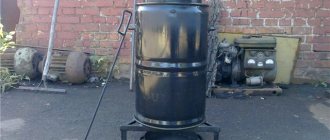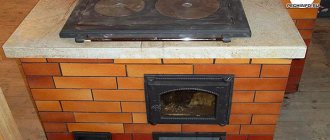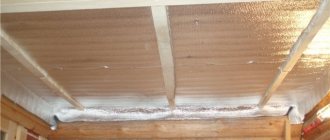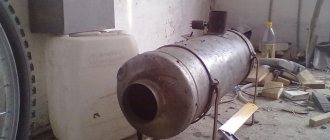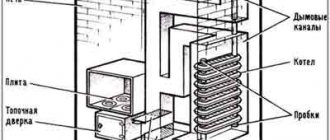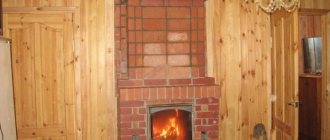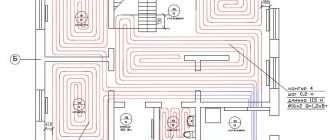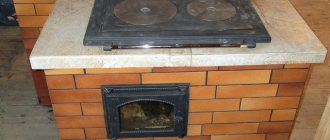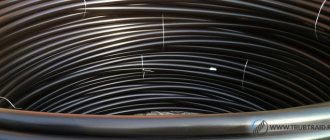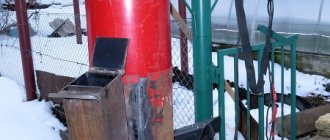Features of protective finishing of ovens
With regular use of the oven, all materials from which it is made are exposed to very high temperatures. They depend on the combustion temperatures of the specific substances that are used as fuel. Of course, the walls of the stove are made of refractory materials, but extreme thermal influences change their structure and properties, which leads to gradual destruction. It is to protect against such influences that the lining is used.
The lining will be the best internal protection of your hearth from burnout and other damage.
Description of the process and purpose of the lining
Lining is a protection against burning out of the internal volume of the furnace, made with fireclay bricks
Lining is the lining of the inner walls of chambers in stoves that are constantly in contact with a flame. It is necessary for brick oven units, which begin to burn and crumble due to moisture loss, as well as for metal stoves and solid fuel boilers. Partitions of furnaces made of steel and other metals are more susceptible to burning out, because of this, many manufacturers supplement them with fireclay or kaolin screens.
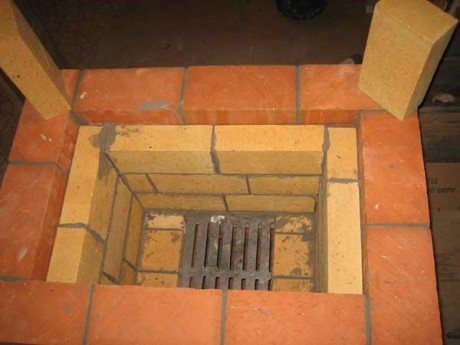
Lining the furnace furnace with fireclay bricks or other material helps to protect the walls from mechanical, chemical, thermal or physical damage. Additional coating helps to reduce heat losses, but for this you need to accurately calculate the thickness of the layer, otherwise the walls will not completely warm up.
We offer you to familiarize yourself with Why the return line of the heating battery is cold
In what cases does it apply
If we are talking about a small hearth, which is used periodically - for heating a country house on a weekend or for cooking in the fresh air (barbecue), then additional protection is not needed here. In such cases, if damage occurs, then they are minimal and will not damage the device in the near future.
Mandatory lining is required for the following types of combustion products:
- Large household and industrial.
- Designed for very long-term use - for example, constant heating of the home.
- Heat chambers, which are arranged for regular cooking in "Russian" and other similar stoves.
- Fuel units, the smoke channels of which are arranged directly along the walls of the furnace.
- In cases where high calorific value fuels with an exceptionally high combustion temperature are used.
Lining types
Lining works are carried out directly inside the firebox of metal, stone and brick devices. This can be done in different ways, depending on what effect is expected and what goals should be achieved:
- It is possible to use special protective screens of heat-insulating action. They will affect the percentage of heating of the flue gases, absorbing a significant part of the radiant fluxes and removing most of the heat through the chimneys.
- The use of materials that will take most of the thermal effect on themselves - fire-resistant with low thermal conductivity, slowing down the heating process of the furnace materials and excluding their direct contact with fire.
Lining work in a brick firebox is carried out by laying out brickwork
ATTENTION! Heat-insulating screens significantly reduce heat transfer, therefore they are not used for furnaces intended for heating rooms.
Methods of execution
The lining of the hearth is usually carried out with the help of so-called "fireclay" materials - specially treated substances and their mixtures with the inclusion of firing elements, destroying the plastic properties and bringing their particles to sintering, as well as other refractory products. It can be:
- Hewn stone made from natural rock such as sandstone or quartz, or conglomerate, resistant to particularly high temperatures.
- Finished fireclay bricks, from which the inner wall is laid. Their refractory properties are achieved due to a special manufacturing technology with the addition of powder from pre-fired clay and other substances that improve the properties of the final product. Protection from such a brick is very popular, as it can withstand almost any temperature of the heating furnace and is relatively cheap.
- Roll materials, plates and mats: basalt fiber,
- vermiculite boards,
- kaolin in the form of paper or cardboard, consisting of mineral white clay.
- fireclay, which are refractory concretes with the addition of a lean component,
Vermiculite finishes can be a great alternative to brick and stone
Materials that can be used for lining.
1) Fireclay bricks 2) Natural stone (sandstone or quartz) 3) Fire-retardant materials in rolls (basalt sheets, vermiculite mats, kaolin paper) 4) Mortars (various refractory concretes and mixtures with which the inner surface of the furnace is coated, as well as silicate-mullite liquid glass mixtures)
In order to correctly calculate what kind of material is required for the lining, you need to know its technological characteristics: - Fireclay brick - withstands temperatures up to 1600 degrees; - Dense kaolin - 1400 degrees; - Vermiculite - 1100 degrees; - Basalt wool - 750 degrees; - Clay brick - 700 degrees.
Let's consider the lining materials in more detail:
1) Fireclay bricks are fired clay products mixed with pre-fired powder from the same clay. Such a brick has a yellow-sand color and a granular structure. But, most importantly, it can withstand temperatures up to 1600 degrees Celsius, has low thermal conductivity, good heat capacity and a sufficient margin of safety to withstand a large amount of incandescence and cooling. The choice of fireclay bricks. Fireclay bricks are produced under different markings, depending on the composition and density. Stove makers recommend using for laying chimneys and stoves SHA-5, ShB-5, ShA-8, ShB-8. Also, when choosing fireclay bricks, experts advise checking their strength - try to split them. Correctly "baked" brick will disintegrate into large pieces, and poor quality brick will crumble. Before buying, make a calculation and provide for a sufficient volume of the desired type of brick - different types of fireclay products cannot be used in the same masonry. They have different thermal expansion.
Comparison table of lining materials
IMPORTANT! In production conditions - at metallurgical and other enterprises where the processing of raw materials and finished products by the hot method is used, the furnace protection is most often made of stone or fireclay bricks. In a “cramped” home, alternatives are more acceptable.
Brick lining
Do-it-yourself lining of the furnace from fireclay bricks is carried out taking into account the following features:
- The brick is neatly laid out "edge to edge", without shifting the elements of the masonry relative to each other, along all the walls of the internal firebox.
- The joints between the individual bricks are filled with a mortar based on chamotte and clay.
- If the main masonry is also made of bricks, then the lining and the main layer are joined by means of one vertical seam, but without bandaging.
- If the material of the furnace itself is metal (cast iron or steel), then a small gap should be left between its walls and the masonry, designed for the thermal expansion of the metal, otherwise regular heating and cooling can soon destroy it.
Finishing with fireclay bricks occurs according to the scheme - along all walls with a gap, taking into account the expansion of materials
ATTENTION! It is also possible to masonry with fireproof red bricks, but it is impossible to mix types of bricks (fireclay plus refractory), since they have different indicators of linear expansion and thermal conductivity, which will make the building short-lived.
Old fireclay brick masonry is subject to regular inspections and repair of worn-out areas, which is carried out by grouting with a mortar of fireclay and alumina cement.
Instructions depending on the material
A layer of cardboard between the inner and outer layers of the masonry
It is better to entrust the lining of a standard or induction furnace to specialists, but with minimal skills, this procedure can be carried out independently, following the rules.
Brick oven
When lining the furnace chamber of a brick oven, the thermal expansion of the material is taken into account. Between the inner protective layer and the outer standard layer of masonry, a gap of 7-10 mm must be left or supplemented with a gasket made of kaolin, basalt or asbestos type cardboard.
Metal oven
Metal furnace lining
The procedure for metal stoves is the same as for brick equipment. It should be borne in mind that there must be a gap between the metal wall and the material to compensate for the linear expansion. This space can be filled with basalt or kaolin slabs or asbestos sheets.
For solid fuel furnaces, it is advisable to carry out the lining in one of three available ways. Heavy lining is carried out for furnaces with weak shielding, with this method, the lining is made by masonry in two or three layers. In the case of lightweight lining, the masonry must be single-layer. There is also a variant of on-pipe lining, when the boiler pipes are coated with refractory glue from the outside.
Clay oven
Fire chambers in clay ovens are recommended to be lined with fireclay bricks or coated with plastic refractory materials, for example, mastic or aluminosilicate glue. After solidification, a layer of such material is a dense shell that protects the walls from overheating.
Fireclay brick
https://www.youtube.com/watch?v=LUtjYiQEEdA
Lining with fireclay bricks is carried out by laying out the material in several rows with a slope and an edge with a shift of up to 1/2 of the length towards the block in the lower row up to the top of the combustion compartment. The upper plane is faced last, laying the bricks flat. It should be remembered that the lining layer and the main masonry of the walls must correspond to each other in the location of the vertical joints.
Tags: boiler, main, furnace, method, such, lining
From roll material
The advantage of using roll materials (as well as plates and mats) is that they take up very little space and do not "steal" the total volume required for fuel filling and smoke passage. The standard thickness of most of them does not exceed 1 cm (for example, thick kaolin cardboard is up to 7 mm thick). To carry out the necessary work, you need to remember that:
- The amount of materials required for the lining is calculated taking into account their linear expansion during heating.
- In some cases, it is possible to lay the canvas in 2 layers, but for household needs this is not at all necessary.
- The individual plates are attached with reinforcement elements - metal pins that are inserted into pre-made grooves.
- When finishing with refractory mats or plates, the sequence of their attachment should be observed: first, the bottom is covered, then the side surface, and then the “ceiling” of the furnace section.
INTERESTING! Many modern factory-made furnaces already have a lining layer on the walls of the furnace sections and do not require additional processing. In particular, steel aggregates are often treated with vermiculite.
Interior finishing can be done with basalt cardboard
DIY lining of furnaces and heating units
Ecology of consumption. Manor: Only refractory materials are used for the construction of the furnaces. But even they are not able to withstand high temperatures for a long time. To protect the outer walls near the firebox from radiation, thermal or chemical influences, a lining is installed inside.
In order for the lining made with fireclay products to be strong, durable and effective, a special solution is required. The best option is ready-made dry mixes adapted for chamotte and laboratory tested for operation. Heat-resistant and refractory compositions for masonry are on the market in an assortment, and the prices are quite affordable, and experiments with lining are more expensive, since the repair and restoration work of heating structures is a laborious and time-consuming business.
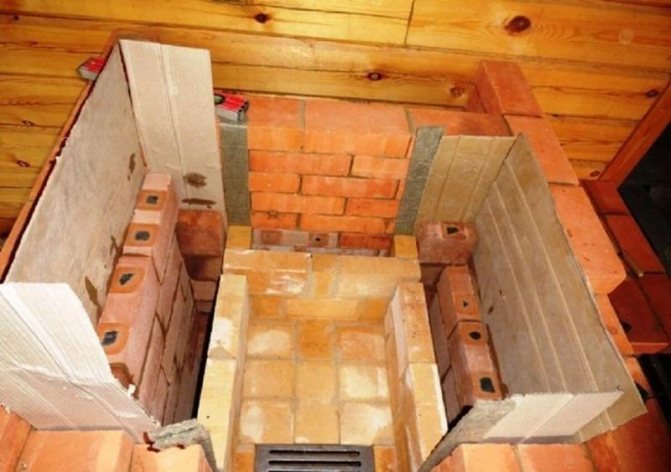

Lining with fireclay bricks
Ready-made dry mixes for lining have manufacturer's instructions on the packaging and information on the exact purpose of the composition. The cladding of furnace sections of furnaces requires refractory mixtures, and for other sections, heat-resistant solutions can also be used. Refractory compositions are much more expensive, but only they should be used for lining furnaces, especially since a little solution is required - you can take at the rate of 70 kg of dry matter per 100 pieces. bricks.
When lining with fireclay bricks, it should not always be soaked before laying, but in certain cases:
- Dry brick quickly absorbs water from the mortar, as a result, the mortar joint sets faster and loses its plasticity. It is very difficult to touch up something, so a good masonry skill is required. If the brick is soaked before work, then it is possible to obtain an additional resource for correcting errors in the masonry by extending the mobility of the mortar mixture.
- When reusing bricks from dismantling old stoves, soaking opens the capillaries and pore structures of the brick, into which dust and solutions have gotten during the service. Moisture and solutions as a result of moistening more easily penetrate into the brick, the adhesion and strength of the masonry increases.
- During summer masonry work, when the air temperatures are high, it is recommended to soak the brick for a short time before laying it. In autumn and winter, this procedure becomes unnecessary and harmful, since waterlogged bricks in the masonry must be dried, and it is unacceptable to heat the stove before natural drying and setting of the mortar in the seams of the masonry - this can cause deformations in the seams of the masonry and reduce its strength. Sometimes drying is carried out using heat from a powerful electric incandescent lamp with all the doors of the stove fully open.
Dry fireclay brick for masonry is preferable, therefore, instead of soaking the brick, you can make the mortar mixture a little less thick in order to have a short time to straighten out possible flaws in masonry work.
Lining with refractory adhesives and pastes
Alternatively, the use of refractory aluminosilicate glue rather than fireclay mortars for linings has invaluable advantages. These compositions are used not only for linings of household furnaces as masonry and coating solutions, but also in metallurgy. use high-temperature adhesives for the installation of products made of basalt and kaolin fiber, ceramic fiber, fireclay products, with excellent adhesion in the end.
Aluminosilicate glue is sold ready-to-use, in sealed plastic containers of different packaging, at least 2 kg.
Lining using refractory glue includes the following steps:
- Before work, the glue is thoroughly mixed until completely homogeneous.
- Apply glue to pre-moistened surfaces with steel spatulas. On the walls of the furnace section and / or other elements of the lining, the glue is applied in a thin layer - no more than 3 mm. In the case when the lining is carried out only with an adhesive layer, without sticking cardboard or other materials, then the glue is applied 3-4 times, with an exposure of each layer for about 15 minutes.
- When fixing basalt cardboard on horizontal surfaces, you can dilute the adhesive mass with water up to 15%. The consumption of the adhesive is influenced by the quality of the surfaces to be treated and the thickness of the applied layers, the glue can be consumed per square meter. Meter within 2-4 kg.
- The glue layer dries completely in a day, if the temperature is not lower than 25⁰С and the thickness of the application is not more than 3 mm. At high temperatures (over 85⁰C), complete drying occurs in 5-7 hours.
Lining of furnaces for brick stoves and fireplaces
When lining the walls of the furnace sections, it is imperative to take into account the inevitable thermal expansion of materials under temperature influences when furnaces, fireplaces or boilers are in operation. Internal protection from a layer of chamotte and an external masonry layer of ordinary red brick should have an expansion gap of 0.7-1.0 cm and / or an interlayer of asbestos board, basalt or kaolin sheet, or roll material. Direct contact of the outer wall of the furnace section with the furnace lining is unacceptable, there must be either a free gap or filling with a heat-resistant material, otherwise the difference in the temperature expansion of the materials will cause deformations and the structure will gradually collapse.
Before the start of laying, the need for materials is calculated. Fireclay bricks with standard dimensions of 250 * 150 * 65 mm are more common. Fireclay products are produced in a large assortment, which makes it possible to select fireclay for a configuration of any complexity - for combustion chambers, fireplace vaults, arches, etc. streams. In fireplaces, the inner walls are made with a slope so that heat goes into the room, and the combustion products are directed into a precisely calculated opening. In the same way as in the furnaces of furnaces, expansion gaps between the fireclay lining and the outer brick walls are required in fireplaces.
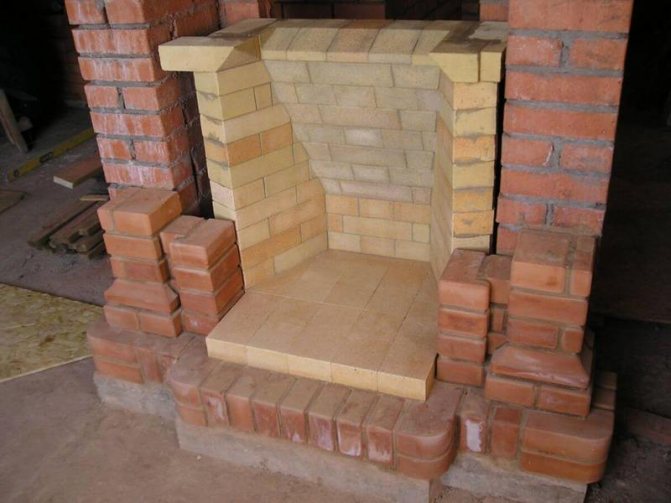

The thickness and materials for the lining are selected based on the operating mode of the furnace or boiler unit. In order to strengthen the fireclay masonry, reinforcement is also used. Seams are reinforced with steel wire with a diameter of 3 - 5 mm in every second row. When the furnaces are erected according to the schemes-orders, then the lining is made in parallel, and all the dimensions have already been calculated and painted in the order, as well as the shapes and sizes of fireclay products.
But if you need to lining the furnace of an already built furnace, the stages of the process are as follows:
- The first row of fireclay bricks is laid around the grates, and a brick with an inclined edge is preferred to provide a slope in the direction of the grates.
- In finished fireboxes, it is extremely difficult to lay out the back wall with an inclination, so you have to make them even. The back and side walls of the lining are raised simultaneously.
- With small sizes of furnaces and the need for their lining, not fireclay bricks are used, but thin-walled fireclay panels or plasters with a paste-like refractory composition. When applying coatings, it is necessary that the entire surface has been processed. Before work, arrange the top lighting by removing the cast-iron rings from the burners.
When lining furnaces of any size, as well as during laying, it is unacceptable to combine ceramic heat-resistant bricks and refractory fireclay bricks. These materials vary greatly in density and linear expansion, and in addition, they have a different coefficient of thermal conductivity. The combination of chamotte and red brick will give masonry, subject to deformation when heated, unstable and unreliable, and the main red brick is the first to crack and collapse. To compensate for thermal expansion, gaps with a refractory sheet made of asbestos, basalt or kaolin are always needed between chamotte and ceramics. In small furnaces with lining, it is also difficult to arrange gaps, but this is necessary, at least with a minimum size of half a centimeter.
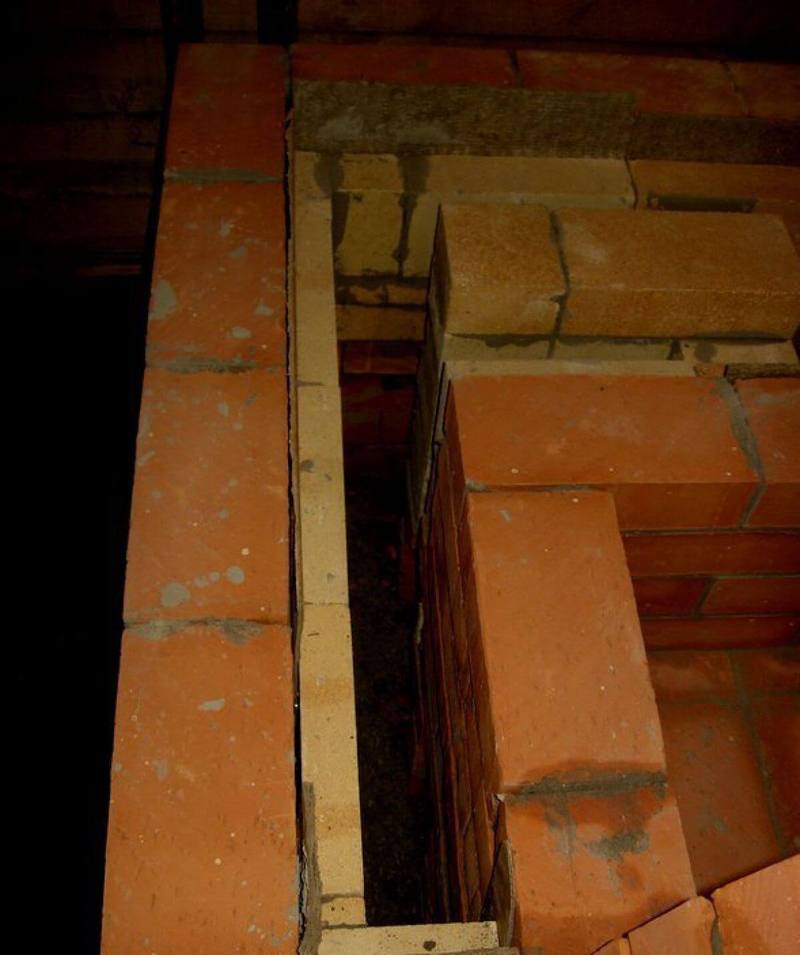

Metal furnace firebox lining
The linear expansion of metal and chamotte is incomparable with similar parameters of bricks of different types, therefore, when lining steel furnaces, the question of gaps does not even arise. The thermal gaps between the steel sheet of the furnace and the fireclay are filled with asbestos, but kaolin or basalt wool or mats are preferable.
The lining of metal heating furnaces inevitably reduces the heating efficiency, since part of the heat from the combustion of the fuel will go not to warm up the walls, but to the chimney. Therefore, in the presence of the inner lining of the furnaces, it is completely unnecessary to make the outer lining of the steel stove with ceramic bricks - the high heat capacity and low thermal conductivity of the ceramics will greatly reduce the heat transfer from the furnace.
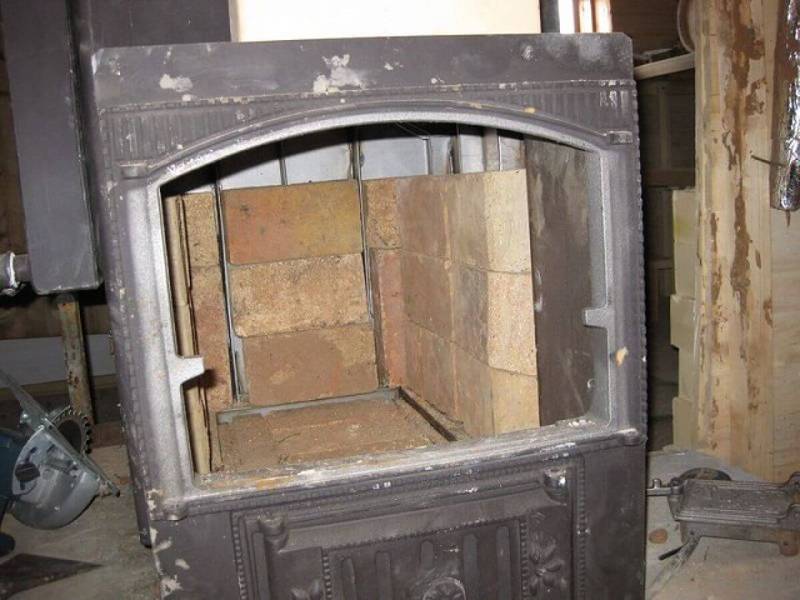

They begin to veneer the metal firebox from the bottom to the top, just like a brick one - they lay out the bottom, on a flooring made of, for example, basalt cardboard no thinner than 1 cm.Cardboard or sheets of other heat-resistant material are fixed with refractory glue.
Differences in the lining of solid fuel boilers
The peculiarities of the boiler lining are in taking into account the specifics of the work - the boiler unit must generate heat energy and continuously transfer it to the heat exchange circuit to the circulating coolant, and heat dissipation through the outer casing by the boiler structures is reduced to a minimum, since in the context of boilers, heat transfer to the outside is heat loss. All this determines the differences between the lining of various boilers, depending on their shielding.
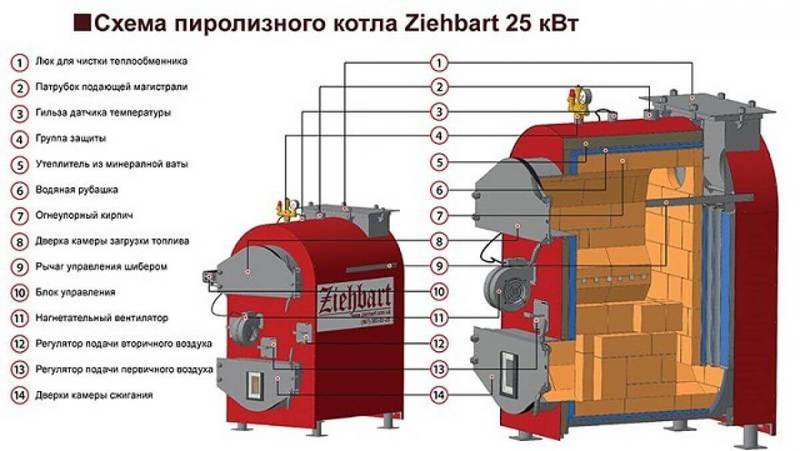

The main three methods of boiler lining
- Rarely used for domestic boilers - heavy linings. If the boiler has weak shielding, and heats up during operation above 1200⁰C, then there are risks that the walls of sheet steel will quickly burn out. In addition, it is no longer safe to service such a unit, and fires are possible. When making heavy linings, fireclay bricks are laid with a spoon in two or even three layers. As a result, the temperature of the outer surfaces of the boiler drops to 80⁰С.
- A single-layer fireclay lining is considered lightweight. At the same time, the outside of the surface of the boilers is additionally lined with non-combustible material based on the specific temperatures to which the unit is heated, and from above, sheathing with sheet steel is also possible.
- The outer lining is made of refractory compounds - glue, viscous coatings or pastes in order to thermally insulate the pipes from above. This simple method of lining is used in areas where it is difficult or impossible to use other heaters due to strong heating. Apply a coating lining with brushes two, less often three or four times, laying a reinforcing fiberglass mesh. Steel meshes are not used, because when heated, they give too much linear expansion.The mesh provides protection against possible through mechanical damage to the lining layer. This thickened multi-layer lining prevents heat loss through the pipes.
Features of the lining of the furnaces of molded clay stoves
The molded adobe stove is now in great fashion, and the variety of such stoves, both in design, in structure and in size, is growing, despite the huge range of cast iron and steel stoves and all the necessary building materials for the construction of brick stoves. Stucco ovens are special - they are very ancient, time-tested and highly functional, and they heat and "heal" and create an exclusive chic. The quirky stucco stove with stove benches is now an undeniable powerful trend. The furnace of a molded adobe stove also needs protection - lining.
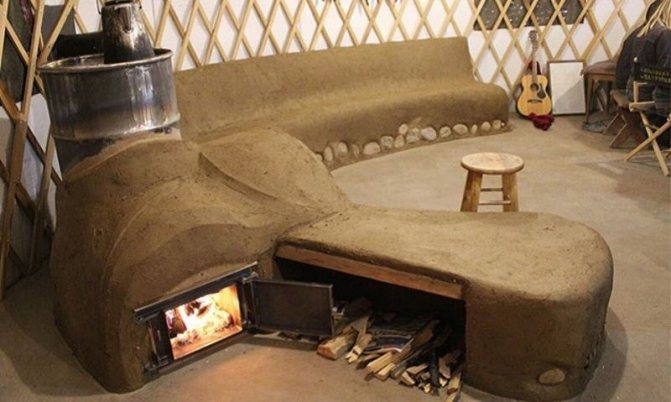

For stucco furnaces, experts recommend using fireclay as linings. A small exception - if the stove is composed of a mortar mixture with stone reinforcement (a rather complex technology on the verge of art), then it is possible to limit oneself to a lining with refractory glue or pastes. The same compositions are used as for furnaces and boiler pipes - mullite or corundum mixture, special expanding alumina cements, chamotte mortar mixtures or marls, as well as adhesive aluminosilicate compositions.
Lining with pastes and viscous adhesives is simple and does not require high qualifications, but only accuracy and attention. When the refractory mixture hardens, it forms a monolithic protective shell and will not allow the main clay walls of the furnace to crack under strong heating.
Lining, repair and restoration of furnace combustion chambers
All ovens are subject to revision checks before starting a new season of operation after the summer months. During the summer downtime, impacts are possible, the results of which are not immediately noticeable, but will lead to cracks and chips at the beginning of the furnace. These phenomena not only reduce the efficiency of heat transfer from the stove, but can also become very dangerous - these are the risks of carbon monoxide in the residential area. Carbon monoxide, or carbon monoxide, a gas without taste, color and smell, extremely dangerous to health and life - this information is trivial and familiar to everyone. Revisions of the furnace after downtime are carried out on the outer brick (lined, plastered, tiled, etc.) layers, as well as, without fail, and on the inner surfaces of the existing lining. All cracks and damage are carefully repaired.
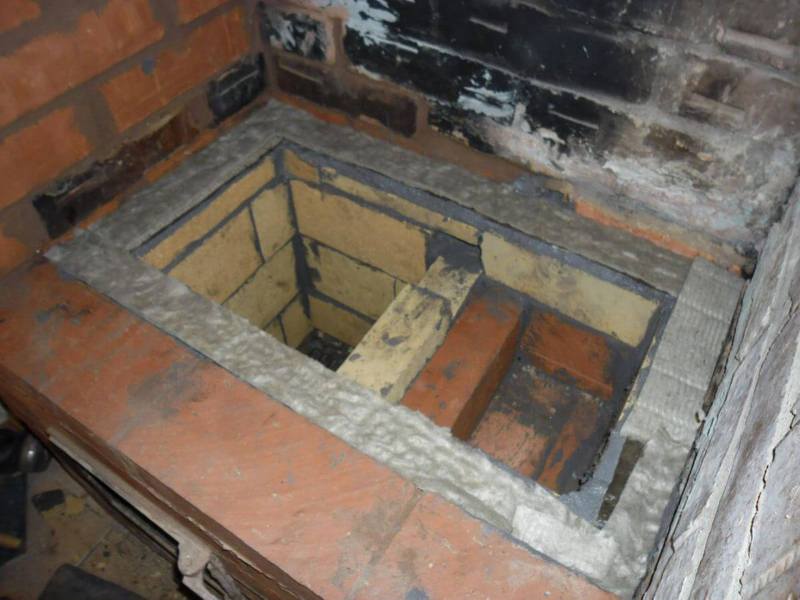

The lining is repaired with refractory coatings - mastic, glue, mortar. It is enough to restore the outer surfaces with a heat-resistant material. After repair work, the furnace should be heated no earlier than the refractory and heat-resistant material has completely dried and set, and only by natural drying. Deformations in the areas of embedments occur if the furnace is started to heat immediately after repair.
Independent lining of the furnace and boiler is possible, but it requires knowledge and some experience, therefore, they often turn to professionals about these issues. After all, it is not enough just to carry out the work, you also need to calculate the required thickness of the lining and choose the right material from a considerable range of materials. published
If you have any questions on this topic, ask the specialists and readers of our project here.
P.S. And remember, just by changing your consumption - together we are changing the world! © econet
Coating with solutions
Coating with refractory mortars results in an even thinner lining layer. This method is characterized by the following nuances:
- For the preparation of solutions, dry compositions of chamotte, mullite or corundum mixtures are usually used, which are then diluted with water to the desired consistency.
- After application, the solution must be fired under natural conditions (when the oven is operating) or using a blowtorch.In the second case, work is carried out until a hard crust appears.
IMPORTANT! The advantage of the mortar method is also the creation of absolutely monolithic surfaces, which give the best protection of materials from the effects of fire. However, such a monolith will require repairs faster than masonry and brickwork.
The well-thought-out protection of the stove will guarantee warmth and comfort for many years

